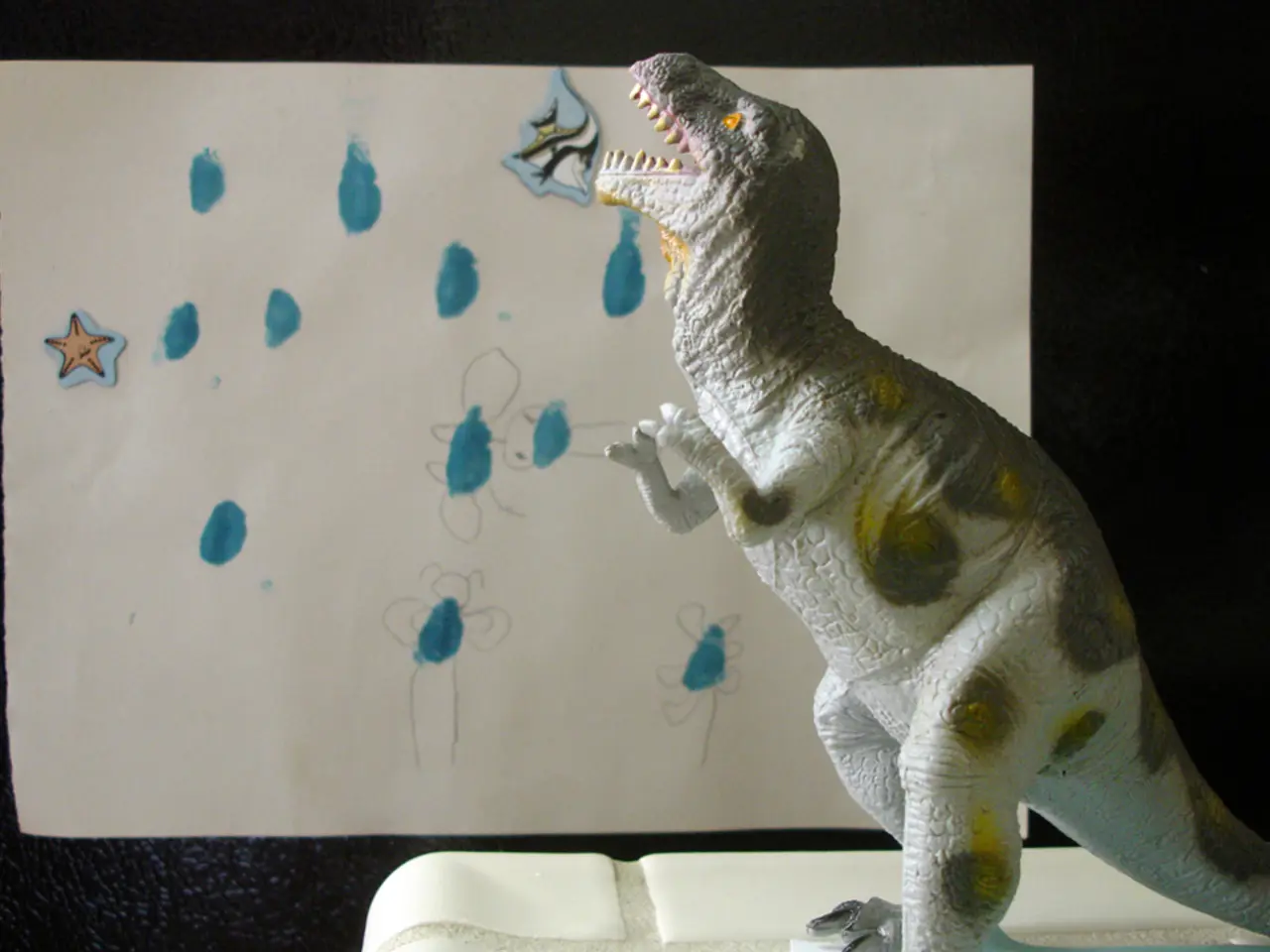Sauropods' Dietary and Migratory Habits Unveiled by Fossilized Teeth Analysis: New Research Discloses Eating Patterns and Migratory Movements of These Prehistoric Beasts
In a groundbreaking study published in the prestigious journal Nature Ecology and Evolution, researchers have delved into the lives of sauropod dinosaurs, shedding light on their feeding behaviors, migration patterns, and the environmental conditions they experienced around 150 million years ago.
The study, titled "Dental microwear texture analysis reveals behavioral, ecological, and habitat signals in Late Jurassic sauropod dinosaur faunas," was conducted by a team of researchers from the Free University of Berlin, Christian-Albrechts-Universität zu Kiel, University of NOVA Lisbon, and the Leibniz Institute for the Analysis of Biodiversity Change (LIB).
The research team, led by Emanuel Tschopp from the Free University of Berlin, used a method called Dental Microwear Texture Analysis (DMTA), which analyzes tooth enamel surfaces in the micrometer range. This technique provides detailed insights into a dinosaur's feeding behavior, offering a window into the last days and weeks of its life.
The study analysed three Late Jurassic sauropod faunas from the USA, Portugal, and Tanzania, each with extreme sauropod diversity but differing climate regimes. The findings include:
- Feeding Behavior and Niche Partitioning: Different sauropod clades showed distinct microwear textures on teeth, indicating varied dietary preferences and food processing strategies. For example, North American camarasaurids and Portuguese turiasaurs (both broad-crowned taxa) had similar wear patterns, but where they co-occurred in Portugal, their distinct microwear differences suggest niche differentiation, likely avoiding direct ecological competition.
- Migration Patterns: Camarasaurids exhibited minimal variation in dental wear across different climate zones, supporting the idea that they migrated seasonally to track favorable climate niches and food availability. In contrast, flagellicaudatan diplodocoids showed highly variable wear patterns indicative of limited migration and seasonal diet changes tied to localized habitats.
- Environmental Conditions: Early-branching titanosauriforms' tooth wear varied significantly between regions, probably reflecting differences in habitat abrasiveness and plant abrasiveness due to varying climatic and ecological conditions.
Titanosauriforms from Tanzania showed strong and complex wear, likely due to quartz sand-contaminated food in the semi-arid Tendaguru Formation environment.
André Saleiro from the University of NOVA Lisbon emphasizes that environmental conditions leave traces, as demonstrated by the study's findings. Daniela Winkler, a postdoc at the University of Kiel, describes the DMTA approach as "a window into the last days and weeks of a dinosaur's life," with each new sample providing another puzzle piece.
The study includes 39 sauropod individuals from various genera, including Flagellicaudatans like Diplodocus, Camarasaurians from Portugal and the USA, and Titanosauriforms from Tanzania. Further analyses are planned, including the feeding behavior of sauropod juveniles and the adaptation of small species like Europasaurus from Lower Saxony.
Emanuel Tschopp emphasizes the importance of interdisciplinary collaboration in the study, bringing together paleontology, modern technology, and ecology to gain insights into past worlds. The LIB is a member of the Leibniz Association, which unites 96 research institutions from various disciplines.
The original publication of the study can be found in the journal Nature Ecology and Evolution. This study not only sheds light on sauropod diets but also reveals behavioral ecology such as resource partitioning, competition, and migration linked to habitat and climate during the Late Jurassic, deepening understanding of these megaherbivores' life history in their ecosystems.
[1] Tschopp, E., Mateus, O., Winkler, D. A., et al. (2021). Dental microwear texture analysis reveals behavioral, ecological, and habitat signals in Late Jurassic sauropod dinosaur faunas. Nature Ecology & Evolution, 5, 1062–1071. https://doi.org/10.1038/s41559-021-01495-y
[2] Tschopp, E., Mateus, O., Winkler, D. A., et al. (2021). Dental microwear texture analysis reveals behavioral, ecological, and habitat signals in Late Jurassic sauropod dinosaur faunas. Retrieved October 20, 2022, from https://www.nature.com/articles/s41559-021-01495-y
[3] University of Kiel. (2021, October 19). Dinosaur teeth reveal secrets of their feeding behavior and migration patterns. ScienceDaily. Retrieved October 20, 2022, from https://www.sciencedaily.com/releases/2021/10/211019103448.htm
[4] Free University of Berlin. (2021, October 19). Dinosaur teeth reveal secrets of their feeding behavior and migration patterns. ScienceDaily. Retrieved October 20, 2022, from https://www.sciencedaily.com/releases/2021/10/211019103448.htm
[5] Nature Ecology & Evolution. (2021). Dental microwear texture analysis reveals behavioral, ecological, and habitat signals in Late Jurassic sauropod dinosaur faunas. Nature Ecology & Evolution, 5(10), 1062–1071. https://doi.org/10.1038/s41559-021-01495-y
- The study conducted by a team of researchers from several universities, including the Free University of Berlin and the University of NOVA Lisbon, utilized technology called Dental Microwear Texture Analysis (DMTA) to investigate the feeding behavior, migration patterns, and environmental conditions of sauropod dinosaurs.
- The research findings suggest that technology such as DMTA can provide valuable insights into the relationship between medical-conditions (specifically the conditions of dinosaurs, but applicable to all living beings, metaphorically speaking) and their respective environments, shedding light on the behavior, ecology, and habits of these ancient creatures.




